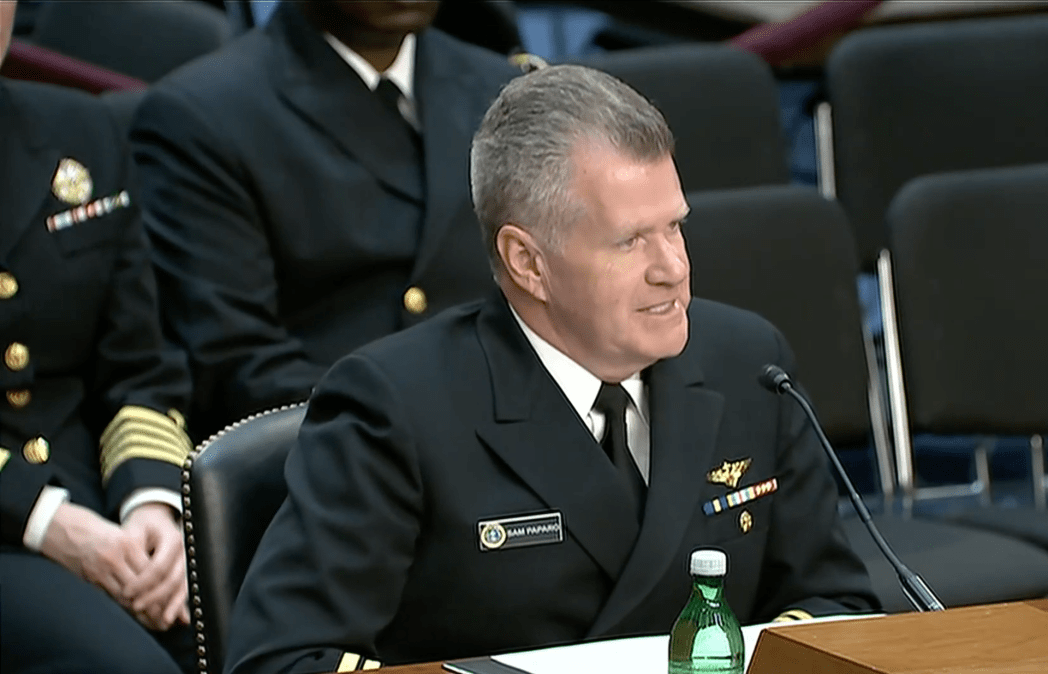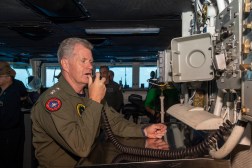Counter-C5ISRT is top priority for nominee to lead Indo-Pacific Command

Boosting the U.S. military’s ability to “blind” Chinese forces is at the top of the priorities list for the officer nominated to be the next commander of Indo-Pacific Command, he told lawmakers.
During his confirmation hearing Thursday and in written responses to advance policy questions, Adm. Samuel Paparo, who currently commands Pacific Fleet, noted the importance of being able to counter the People’s Liberation Army’s command, control, computing, communications, cyber, intelligence, surveillance, reconnaissance and targeting (C5ISRT) systems.
Behind defense of the homeland, C-C5ISRT is the top priority for U.S. Indo-Pacom, he told the Senate Armed Services Committee.
“It has been the number one priority that I’ve communicated to the chief of naval operations in my integrated priority lists. And if confirmed, it is the enabling capability … that will bring victory to the allies” in a potential conflict with China, he said.
In their list of advance policy questions, lawmakers asked Paparo to identify the key areas in which each U.S. military service must improve in order to provide the necessary capabilities and capacity to the joint force to prevail in a potential conflict with the People’s Liberation Army.
“Specifically, the joint force requires capabilities to blind (Counter-Command, Control, Computing, Communications, Cyber, Intelligence, Surveillance, Reconnaissance and Targeting (C-C5ISRT), see (persistent real-time awareness of the battlespace in all domains) and kill (long-range precision fire enabled the Joint Fires Network). Additionally, we require capabilities that assure air superiority, sea control, undersea warfare dominance, space control, integrated air and missile defense, and logistics to support our distributed operations. If confirmed, I look forward to working cooperatively with each service regarding these capabilities,” he wrote.
In addition to blinding the PLA, the Department of Defense must be able to maintain a “persistent stare” at the operating environment through a variety of sensors, he noted.
“ISR is inherently, due to the ephemera of the capability, blinking. The closer we can come to a persistent stare from the seabed to the surface of the sea, distributed throughout geography, in the air and in the [space] constellation — all of it must sum to a persistent stare of [People’s Republic of China] forces in response to this shrinking strategic, operational and tactical warning,” Paparo said.
The Pentagon has identified sea, air, land, space and cyberspace as warfighting domains. The latter two are where the “fist battle” will take place in a potential conflict between the Pentagon and the PLA, Paparo said.
In 21st century warfare, the advantage goes to the side that can see, decide and act faster, according to the admiral.
The Defense Department is pursuing a next-generation warfighting construct known as Combined Joint All-Domain Command and Control (CJADC2), which calls for more effective and holistic networking of sensors, shooters and data streams across the entire battlespace from all the services and key foreign partners to provide the right data to commanders for better decision-making.
“Increasingly, we’re dependent on our cyber networks and in our constellations to be able to see, understand, make sense of and to act. And accordingly, we must build the resiliency of our constellation of sensors on orbit, as well as our constellation of … sensors from the seabed to the Karman Line. They must be resilient, they must be redundant, they must include the elements of graceful degradation so that when one thing is out, it’s just a small loss in capability, but it’s still it still provides enough. And we’ve got to work tirelessly to close those gaps,” Paparo told lawmakers.
“If and when conflict comes, it is that C5ISR in space and cyber, that shall be the first battle and will be either the enabling capability for the joint force, or the Achilles heel for the PLA if that day comes,” he added.
U.S. advances in cutting-edge and emerging technologies such as AI, directed energy, hypersonic missiles and quantum computing will also be critical as Washington seeks to keep pace with Beijing, he noted in his written responses to policy questions.
The Pentagon and its allies in Australia and the United Kingdom are partnering to work on these types of capabilities under what’s known as pillar two of the AUKUS alliance.
However, trilateral cooperation under AUKUS has faced hurdles from U.S. export control restrictions that have limited technology sharing with allies, according to Paparo.
AUKUS provisions that were included in the fiscal 2024 National Defense Authorization Act “should alleviate these challenges significantly. As we begin working within the new authorities, and if confirmed, I will alert the committee to any impediments that may arise,” he told the panel.





